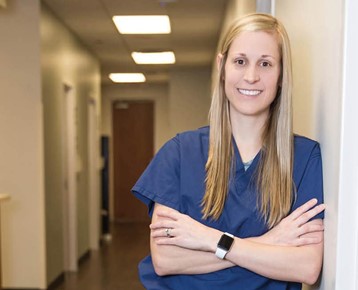What is Dense Breast Tissue?
About half of women 40 years old or older have dense breast tissue[2], which is detectable via a mammogram. Density isn’t related to breast size or firmness; it’s a measure of the percentage of the breast tissue that is fibrous or glandular tissue relative to the amount of fatty tissue.
“There are four levels of density,” according to Meghan Hansen, M.D., a board -certified general surgeon specializing in breast surgery on the medical staff at Texas Health Center for Diagnostics and Surgery. “Some women’s breasts are composed almost entirely of fatty tissue, others have scattered areas of density, some are heterogeneously (evenly) dense, and some are extremely dense.” The latter two categories are considered “dense breast tissue.” 
“Any time we read a mammogram, we classify the density of the patient’s breasts,” added Cory Morgan, M.D., a board-certified diagnostic radiologist on the medical staff at Texas Health Center for Diagnostics and Surgery.
What causes dense breast tissue? “It’s mostly genetics,” according to Dr. Morgan. “However, a woman’s breast tissue makeup can change, due to weight gain or loss, hormonal changes or hormonal replacement therapy, or when a woman is breastfeeding or stops breastfeeding.” 
All women should have regular annual mammograms beginning at the age of 40. But those with dense breast tissue can consider additional imaging. There are two reasons for that: First, women with dense breast tissue are at higher risk for developing breast cancer, although it’s not a huge risk factor.[3] Second, for women with dense breast tissue, it can be more difficult to detect tumors via regular mammograms, because the density can mask subtle evidence of cancer on the mammogram.[4] “The guidelines for the best type of screening for women with dense breast are not clear-cut, however,” Hansen said. Additional imaging can include a screening breast ultrasound or a breast MRI given other associated risk factors.
Typically, a breast MRI is not recommended for women who have dense breast tissue unless they have other, additional risk factors such as family history of breast cancer or a high-risk biopsy in the past. [5]
What is a Breast MRI?
Magnetic resonance imaging (MRI) uses a strong magnet instead of radiation to make very detailed, cross-sectional pictures of the breasts. For the scan, a contrast material called gadolinium is injected into a vein during the exam. Unlike contrast dyes used in CT scans, gadolinium does not contain iodine. The test is painless and usually takes less than 30 minutes.
There are a variety of reasons breast MRIs are recommended. Dr. Hansen often recommends a breast MRI for newly diagnosed breast cancer patients with dense breast tissue, as a way of setting a baseline and detecting malignant tissue. But the breast MRI is useful, too, as a screening tool for some patients who don’t have cancer. “I wouldn’t necessarily recommend a breast MRI every year, but it can work well as an additional tool for screening between annual mammograms, or to establish a baseline for the appropriate patient,” she said.
Breast MRI for Screening
For women with dense breast tissue, who have not been diagnosed with breast cancer, it’s a good idea to ask a medical provider about the option of additional screening. This may only be the addition of screening breast ultrasounds. However, in specific patient populations including those with a family history of breast cancer (a mother, sister or daughter who had breast cancer), those who’ve had genetic testing that indicates high risk, or those who have had a high-risk lesion found on breast biopsy in the past, a breast MRI may be indicated.[6]
Coming up with the best strategy for breast cancer screening is a complex question. Patients and their medical practitioners must carefully weigh the potential downsides of additional testing against the risk of developing the disease. Women with dense breast tissue and/or other risk factors may wish to consult a specialist for guidance on the best screening strategy.
“We work with patients who do not have breast cancer but have family histories of breast cancer or other risk factors,” said Dr. Hansen. “We have risk calculators that help estimate each patient’s lifetime risk to develop breast cancer.” For those whose lifetime risk to develop breast cancer is over 20%, Dr. Hansen often recommends a breast MRI. In those cases, most insurance plans will cover the MRI.
Dr. Hansen added that breast MRIs don’t have significant medical risks, but there is a potential downside. They sometimes detect masses that may be benign – “false positives” – that lead to additional imaging (such as an ultrasound) or possibly even a biopsy to rule out cancer.
At Texas Health Center for Diagnostics and Surgery, breast MRI is one of several diagnostic imaging tools used to help patients with their medical needs. Dr. Hansen emphasized that every patient is different, but after age 40, every woman should have an annual mammogram.
“And for those with dense breast tissue, who also have other risk factors, a breast MRI can be an excellent option for additional screening,” she said.

Frequently Asked Questions
Is ultrasound better for dense breasts?
Not necessarily. “A mammogram is still the preferred tool for breast cancer detection,” said Dr. Morgan. “Nothing should replace a screening mammogram as the primary diagnostic tool. However, an ultrasound and/or a breast MRI can be useful adjuncts to augment the screening.” Talk to your doctor to determine the best screening strategy given your medical history.
Can dense breast tissue cause cancer?
Not exactly. Dense breast tissue doesn’t cause cancer, but women with dense breast tissue do have a somewhat higher risk of developing breast cancer in their lifetimes. “Cancer develops in the glandular or ductal tissue,” said Dr. Morgan. “A woman with a higher percentage of that tissue – in other words, with dense breast tissue – statistically has a higher chance of developing breast cancer.” However, most women with dense breast tissue will not develop breast cancer in their lifetimes. [7]
Can an MRI detect cancer?
Yes. “An MRI can detect cancers – including some that may not show up on a mammogram,” said Dr. Morgan. “But it can also detect benign masses. Thankfully, most of what shows up on an MRI are fibroadenomas, which are benign, as well as cysts, dilated ducts, lymph nodes or sebaceous skin lesions.”
How long does a breast MRI take?
Breast MRI scans can usually take between 20 and 35 minutes.
Why would a doctor order a breast MRI?
There are a variety of reasons. The most common is for evaluating the extent of disease for a patient who has been diagnosed with breast cancer. “A breast MRI can show whether cancer is present in another area of the breasts, or if the lymph nodes are abnormal,” said Dr. Morgan. “This gives additional information to the surgeon and oncologist as they plan the treatment.”
But the breast MRI is useful, too, as a screening tool for some patients who don’t have cancer – provided they have dense tissue. “I have found in the past that for women who have less dense breasts, the MRI rarely adds anything that the mammogram doesn't already detect,” Dr. Hansen said. “Which is good, because that tells me the mammogram is fairly reliable for women who don’t have dense breast tissue.”
In breasts that are dense, cancer can be hard to see on a mammogram. An MRI can help find cancers that can’t be seen on a mammogram. However, an MRI may show more findings that are not cancer, which can result in added testing.[8]
What does a breast MRI show?
Contrast dye injected in the patient highlights or “enhances” the cancerous or potentially cancerous tissue. “As the radiologist, what I’m looking for on the MRI is for tissue that's abnormally enhancing or that's enhancing differently from anything else in the breast, in patterns that could suggest cancer,” said Dr. Morgan.
Breast MRIs at Texas Health Center for Diagnostics and Surgery employ a technique called “dynamic post contrast imaging.” Immediately after the dye is injected, a set of images is taken. After a minute or so, another set of images is taken, and so on, until four sets of images are completed. The pattern that emerges over time provides additional useful information to the radiologist on the medical staff.
“On MRIs, breast cancers tend to enhance earlier than normal breast tissue,” Dr. Morgan said. “They take up the contrast faster, and they lose it faster, compared to normal breast tissue.”
How is a breast MRI done? What to expect for a breast MRI?
For a breast MRI, the patient lies face down on a narrow, flat table, with breasts hanging down through an opening in the table, so they can be scanned without being compressed. The table then slides into the MRI machine. The test is painless but does require the patient to lie still during the procedure. Patients with claustrophobia should discuss this concern before undergoing the test; in some cases, medicine is provided to help patients relax during the procedure.
In addition to providing diagnostic imaging services, the physicians on the medical staff at Texas Health Center for Diagnostics and Surgery offer a variety of treatment options for various medical conditions including endoscopic spine surgery, artificial disc replacement, hip replacement surgery, knee replacement surgery, ENT services, and urology services for men and women.
[1] Katie Couric Media blog post. https://katiecouric.com/news/katie-couric-has-breast-cancer/
[2]“What does it mean to have dense breasts?”, Centers for Disease Control and Prevention (CDC) https://www.cdc.gov/cancer/breast/basic_info/dense-breasts.htm
[3] What does it mean to have dense breasts?”, Centers for Disease Control and Prevention (CDC) https://www.cdc.gov/cancer/breast/basic_info/dense-breasts.htm
[4]Dense Breasts: Answers to commonly asked questions. National Cancer Institute. https://www.cancer.gov/types/breast/breast-changes/dense-breasts#does-having-dense-breast-tissue-affect-a-mammogram
[5] American Cancer Society Recommendations for the Early Detection of Breast Cancer. See section for women at high risk. https://www.cancer.org/cancer/breast-cancer/screening-tests-and-early-detection/american-cancer-society-recommendations-for-the-early-detection-of-breast-cancer.html
[6] American Cancer Society Recommendations for the Early Detection of Breast Cancer. See section for women at high risk. https://www.cancer.org/cancer/breast-cancer/screening-tests-and-early-detection/american-cancer-society-recommendations-for-the-early-detection-of-breast-cancer.html
[7] Dense Breasts: Answers to commonly asked questions. National Cancer Institute. https://www.cancer.gov/types/breast/breast-changes/dense-breasts#does-having-dense-breast-tissue-affect-a-mammogram
[8] Breast Density, Patient Information Sheet, the American College of Radiology. https://www.acr.org/-/media/ACR/Files/Breast-Imaging-Resources/Breast-Density-bro_ACR_SBI.pdf

